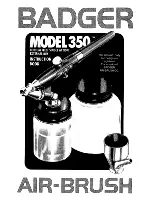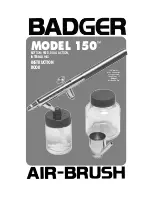
13
O R I G I N A L I N S T R U C T I O N S
GB
with both hands. Adopt a position which prevents the tool from recoiling. Point the nozzle outlet at a safe place, press and hold
the switch. Check that the tool does not generate excessive noise or vibration. If you notice any signs of malfunction, stop using
the tool immediately. Disconnect the tool from the compressed air supply and rectify the fault before continuing with the work.
Plastering
Use water-based masonry mortars. It is forbidden to use mortars based on fl ammable solvents, petrol, alcohol, etc. Spraying such
substances may cause fi re. Do not spray powders, granules. Do not use the plastering machine as a sanding tool.
Prepare a container with plaster mortar. The mortar density should not be too low, so that it does not spill through the outlet
openings when placed in the tool tank. It should be noted that the diameter of solid elements in the mortar should not exceed the
diameter listed in the table with technical data - parameter: “Maximum diameter of sand grains”.
Prepare a container, e.g. a bucket or construction tub of such size that the whole tool container will fi t in it. Fill the container with
water. Place the tool tank and nozzles in this container so that the mortar residue in the tank does not set during short breaks. The
mortar and water container must be placed close to the work area, but must not interfere with the work or present a risk of tripping.
Place the tool fl at on the ground, fi ll the tool tank with plaster mortar. Connect the tool to the compressed air supply. Lift with both
hands, adopt a balanced posture which will ensure countering the recoil. Apply the tool to the plastered surface so that the open-
ings in the tank are no further than 5 - 10 cm from the surface to be plastered (IV). Press the power switch and start plastering.
While plastering, constantly move the tool to avoid uneven covering with the plaster. Move the tool in a steady motion at a constant
speed. Move the plastering machine in such a manner that the outlets of the mortar are at a constant distance from the plastered
surface and parallel to it (V).
Should plastering require the tool to be tilted, e.g. when plastering a ceiling or wall which is not perpendicular to the ground, be
careful not to spill the mortar from the tool tank. In this case, do not fi ll the tank completely.
The work results depend on the pressure of the compressed air, the density of the mortar and the distance between the nozzles
and the plastered surface. It is recommended to carry out a plastering test before starting the proper work in order to adjust the
above parameters to the desired eff ect of the work.
If, during operation, one of the outlets or one of the nozzles becomes blocked, the operation must be stopped. Disconnect the tool
from the compressed air source, remove the mortar from the tool tank, and then proceed with unclogging the nozzle or opening
according to the instructions in the “
Tool maintenance
” section.
During short breaks in work, disconnect the tool from the compressed air supply, remove the mortar residue from the tank, and
then place the tool in the water tank so that it completely covers the tank and the nozzles (VI). Never immerse the tool completely.
The mortar can also harden under water, so do not store the tool too long in this manner.
When the work is fi nished, disconnect the tool from the compressed air supply, remove the mortar residue from the tank, and
proceed with maintenance.
Tool maintenance
Warning!
Each time before beginning maintenance, make sure that the tool has been disconnected from the compressed air system.
Warning!
The tool maintenance should be carried out immediately after each use. Hardened mortar residues will be impossible
to remove and will damage the tool.
Warning!
Never use petrol, solvent, or any other fl ammable liquid to clean the tool. Vapours may ignite, causing the explosion of
the tool and serious injury. The solvents used to clean the tool holder and the body may soften the seals. Thoroughly dry the tool
before starting work.
Empty the tool tank from the mortar residue and then rinse thoroughly with water.
Immerse the tank with nozzles in a water tank or a special water-based liquid for removing plaster mortar, connect the tool to the
compressed air supply and press the switch to remove any residual plaster mortar from the nozzles and outlet openings.
Clean the tank with a water jet with a pressure of not more than 0.3 MPa, a soft paintbrush or brush, and then dry.
Before each use, inject a small amount of preservative (e.g. WD-40) through the air inlet. Connect the tool to the pneumatic sys-
tem and run it for approx. 30 seconds. This will allow the preservative to be spread inside the tool and will clean it. Disconnect the
tool from the power supply. Insert a small amount of SAE 10 viscosity oil into the tool via the air inlet opening and the openings
designed for that purpose. The use of SAE 10 oil is recommended for the maintenance of pneumatic tools. Connect the tool to
the power source and run it briefl y.
Caution! WD-40 cannot be used as a proper lubricating oil.
Wipe off any excess oil which may have escaped through the outlet openings. The oil left can damage the tool seals.
Clean the housing, the handles, all switches and guards with compressed air (with a maximum pressure of 0.3 MPa), a paintbrush
or a dry cloth. Do not use any chemicals or cleaners. Clean the cutter and the handles with a clean dry cloth.
Содержание YT-54400
Страница 21: ...21 RUS...
Страница 22: ...22 RUS II...
Страница 23: ...23 RUS III 5 10 IV V...
Страница 24: ...24 RUS VI 0 3 WD 40 30 SAE 10 SAE 10 WD 40 0 3...
Страница 26: ...26 UA...
Страница 27: ...27 UA II...
Страница 28: ...28 UA III 5 10 IV V VI...
Страница 29: ...29 UA 0 3 WD 40 30 SAE 10 SAE 10 WD 40 0 3...
Страница 81: ...81 GR...
Страница 82: ...82 GR...
Страница 83: ...83 GR II PTFE 5 10 cm IV V...
Страница 84: ...84 GR VI 0 3 MPa WD 40 30 SAE 10 SAE 10 WD 40 0 3 MPa...
Страница 88: ...I N S T R U K C J A O R Y G I N A L N A 88...














































